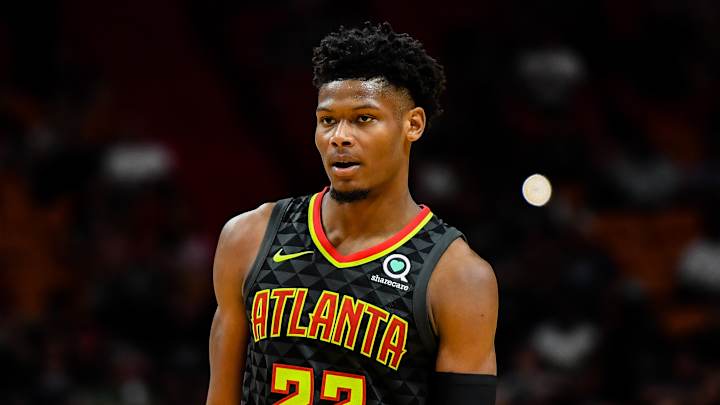Hawks Player Preview: Cam Reddish

In Cam Reddish, two different observers could find equally valid evidence for radically different opinions. Any interpretation of his game depends entirely on one’s vantage point. Optimists may point out his smooth shooting stroke or dexterity with the ball in his hands, but skeptics could just as easily focus on his inconsistent focus or substandard playmaking. Atlanta may well have come away with a steal late in the lottery, but the teams that passed on Reddish in the draft had perfectly legitimate reasons for doing so. He began the 2019 college season a consensus top-five prospect, only to finish outside that range in most every reputable ranking. He struggled to find his place within a Duke offense built around R.J. Barrett and Zion Williamson, oscillating between electric third option and dissenting third wheel. (He also dealt with a core injury that may have significantly hampered his mobility.)
Any optimistic reading of Reddish’s lone season in college is based largely on flashes rather than sustained performance. He undoubtedly failed to maximize his talent in the role he played. That can be partly attributed to Duke’s abundance of talent and lack of spacing, but also to his own inability to fit in. The NBA could provide him more breathing room – both on the court and within Atlanta’s offensive hierarchy. Reddish should have no delusions of being a primary option as a rookie, but in his peripheral role could find opportunity to flourish. He is exactly the sort of player who stands to benefit most from Trae Young’s passing and gravity, which will allow Reddish to find easy shots as he feels his way into an NBA rotation. The augmented spacing should make for cleaner lanes and clearer reads, and Reddish appears to have a better understanding of pick-and-roll machinations than he did in college:
Many of his passes in the preseason were off-target – he finished with three assists and six turnovers in four games – but the fact that Reddish saw and was willing to try those passes could be a sign of improvement. Save for the few who enter the league as visionary playmakers, trial and error is the primary means of growth for young players. Inevitably there will be plenty of error as Reddish adjusts to the NBA game. The trick, and the coaching staff's challenge, will be slowing the game down to a speed that makes sense to him. There's much to learn about a player from how he navigates trials, and staying composed through the nadirs of professional life could prove just as critical as anything Reddish does on the court.
“Cam’s two years removed from high school,” said Vince Carter, whose locker is less than 10 feet from Reddish’s. “Things have gone his way a lot. So this is going to be a little different. You’re going to be on the biggest stage playing against pros, guys who are very good now. And I think the adjustment period takes time, whether you like it or not.”
While the increased space on the floor will help Reddish offensively, it may make the other end of the floor all the more challenging for a player covering more ground and making more reads than he ever has (not to mention learning the nuances of guarding professional scorers). He makes for easy bait for veterans looking to create contact or extra space. “The angles you take [are] important,” Reddish said. “Guys can really score and shoot it, depending on who it is. I feel like it’s a lot of small things like that.” He’s also quite slender, which will likely hinder him on defense and when he attacks the rim. Post bruisers can power right through him while physical guards can simply discard him on their way to the hoop.
In time, however, Reddish could develop into more than just an adequate defender. Players of his physical profile – 6-foot-8, 7-foot wingspan – tend to be versatile on that end, and his length, when properly applied, can be an important asset:
He has the makeup eventually to outgrow his current role of spot-up shooting and tertiary playmaking as well. Exceptionally fluid for his size, Reddish has flashed the ability to score at all three levels, with a compact jumper and fairly advanced handle. He’s shifty moving downhill, gets good extension at the basket, and has sound mechanics on his pull-up jumper – even if the results aren’t always there:
He must significantly improve his feel and passing, though playing in more space could help on both fronts. He can’t afford to drift through stretches of games like he often did in college. For the time being, most of Reddish’s offense will be created by others; spotting up, attacking closeouts, and running occasional pick-and-roll will constitute the vast majority of his diet. He may fall in and out of the rotation, but it won’t change how much he could mean for Atlanta’s future.
If De’Andre Hunter was the prudent play in the 2019 draft, Reddish was Atlanta’s big swing – the kind worth taking with the 10 pick. Taking into account just his strengths, Reddish has unmistakable star potential. Fixate only on the weaknesses, and it’s unclear if he’s even worth the risk. But winning in the NBA, ultimately, boils down to assembling as much talent as possible and allowing it to lift a team to places scheme, cohesion, and effort can’t. Reddish may have that sort of talent. He and the Hawks need only to unleash it.

I am a basketball writer focused on both the broad concepts and finer points of the game. I've covered college and pro basketball since 2015, and after graduating from Indiana University in 2019, joined SI as an Atlanta Hawks beat writer.
Follow @bladner_